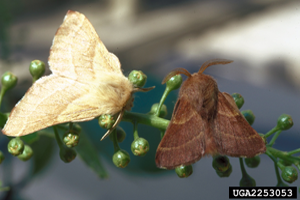|
Do you see/hear...?
|
| Activity
|
Adults
One or more adults are seen or heard moving about or at rest. For Malacosoma californicum, adults may be dark reddish-brown, yellow, tan or gray with two stripes across each forewing.
More...
For abundance, enter the number of individual animals observed in this phenophase.
|
| Reproduction
|
Mating
A male and female are seen coupled in a mating position, usually end to end. This can occur at rest or in flight.
For abundance, enter the number of individual animals observed in this phenophase.
|
|
|
Egg laying
A female is seen laying eggs on a plant or other surface. If possible, record the name of the plant or describe it in the comments field. For Malacosoma californicum, eggs are deposited on twigs, small branches or small stems of trees or shrubs.
For abundance, enter the number of individual animals observed in this phenophase.
|
|
|
Eggs
One or more eggs are seen on a plant or other surface. If possible, record the name of the plant or describe it in the comments field. For Malacosoma californicum, eggs are enclosed in a shiny mass, dark brown to pale gray to grayish-white in color, partially or fully encircling a twig or small branch. Do not include empty egg masses after the caterpillars have chewed their way out of the eggs.
For abundance, enter the number of individual animals observed in this phenophase.
|
| Development
|
Caterpillars
One or more caterpillars (larvae) are seen moving about or at rest. When seen on a plant, if possible, record the name of the plant or describe it in the comments field. For Malacosoma californicum, young caterpillars are dark brown to black with whitish hairs. Older caterpillars can vary in color, but they typcially have a mix of blue-gray, black and orange markings with a dashed stripe down their back, and are covered with orange or orange-brown hairs with white tips.
For abundance, enter the number of individual animals observed in this phenophase.
|
|
|
Caterpillars in tent
Caterpillars are seen in their tent. If possible, record the name of the plant on which the tent is built or describe it in the comments field. For Malacosoma californicum, silken tents are constructed in branches of trees or shrubs and grow larger over time.
For abundance, enter the number of individual animals observed in this phenophase.
|
|
|
Caterpillars feeding
One or more caterpillars are seen feeding. If possible, record the name of the species or substance being eaten or describe it in the comments field. For Malacosoma californicum, caterpillars feed on the leaves of trees and shrubs.
For abundance, enter the number of individual animals observed in this phenophase.
|
|
|
Pupae
One or more pupae are seen in a cocoon or shell (puparium). For Malacosoma californicum, pupae are enclosed in a white, silken cocoon, often dusted with white or yellow powder, and are attached to leaves or branches or found in leaf litter on the ground. Do not include empty cocoons after the adult has emerged from them.
For abundance, enter the number of individual animals observed in this phenophase.
|
|
|
Dead adults
One or more dead adults are seen.
For abundance, enter the number of individual animals observed in this phenophase.
|
|
|
Dead caterpillars
One or more dead caterpillars are seen.
For abundance, enter the number of individual animals observed in this phenophase.
|
| Method
|
Individuals at a light
One or more individuals are seen at a light, whether flying or at rest.
For abundance, enter the number of individual animals observed in this phenophase.
|
|
|
Individuals in a net
One or more individuals are seen caught in a net.
For abundance, enter the number of individual animals observed in this phenophase.
|
|
|
Individuals in a trap
One or more individuals are seen caught in a trap.
For abundance, enter the number of individual animals observed in this phenophase.
|
